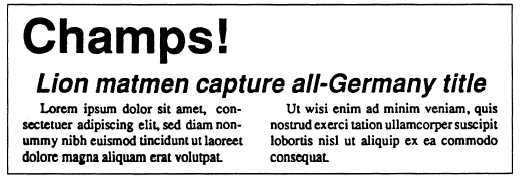Figure 9-7.—Standing head.
Figure 9-8.—Jump head.
Figure 9-9.—Hammer head.
There are countless variations of headline styles, all
of which are viewed in terms of their visual impact when
used with basic headline styles. Some of these variants
are explained in the following text.
STANDING HEAD
The standing head (fig. 9-7) is essentially a label
used for regular or recurring content, such as sports and
chaplains’ columns. It does not change from issue to
issue.
JUMP HEAD
The jump head (fig. 9-8) is designed to help the
reader find a portion of a story continued from another
9-5
page. The jump head uses one or two key words from
the headline that introduced the story. It is set flush left
followed by the words “Continued from Page ##,”
usually set in boldface body type (it also can be set in
italic). A two-point rule maybe used to extend from the
side of the head over the width of the article.
HAMMER HEAD
Often called a reverse kicker, the hammer head
(fig. 9-9) is set twice the size of the main head, set flush
left and is no wider than half the width of the headline
area.







